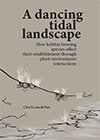PhD defence Clea van de Ven
Clea van de Ven (ConsEco)
Promotor: Prof. T. van der Heide; copromotor: Dr V. Reijers (UU)

A dancing tidal landscape
How habitat forming species affect their establishment through plant-environment interactions
Coastal ecosystems such as salt marshes and seagrass meadows are shaped by habitat-forming plants that can both withstand and modify harsh environmental conditions. In this thesis, I investigated how traits of clonal pioneer species—common cordgrass (Spartina anglica) and dwarf eelgrass (Zostera noltei)—influence early plant establishment in the dynamic intertidal zone. Cordgrass has rigid shoots that contribute to sediment stabilization at maturity, but during early establishment, this same trait increases vulnerability to dislodgement. Eelgrass, with flexible shoots, showed higher tolerance under physical stress.
In a field experiment, sediment and inundation had contrasting effects on both species, and cordgrass was particularly sensitive in the earliest establishment phase. Cordgrass transplants from sheltered donor sites performed better across all conditions, suggesting that plant origin strongly influences restoration success. In naturally establishing cordgrass patches I found a clustered shoot organization that helped reduce flow resistance and erosion. This shoot pattern proved flexible and scaled with patch size, not environmental variation—implying a size-dependent gradual transition from stress avoidance to ecosystem engineering. Furthermore, self-facilitating traits arise from larger patch sizes, highlighting that such facilitative traits are not individual, but emergent. Mimicking these traits with biodegradable structures increased transplant survival, but success was context-dependent, especially in exposed areas.
Together, my findings show that early establishment depends on plant traits, environmental stress, and donor origin. Understanding and mimicking emergent traits, while tailoring strategies to local conditions, can greatly improve the outcomes of salt marsh restoration.
